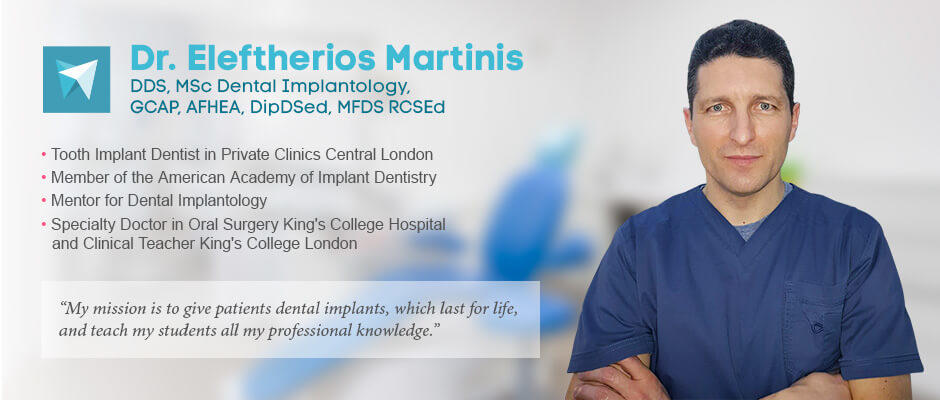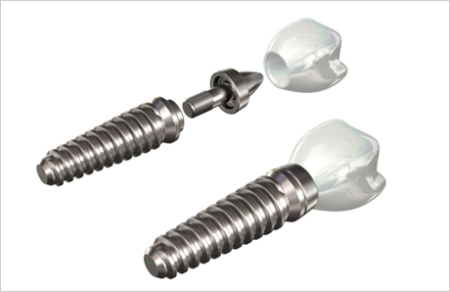Dental implants are artificial tooth roots which are inserted in the jaw bone and used to replace missing teeth. An implant can replace one tooth or with only 4 implants in one arch all the upper or lower teeth can be replaced as 4 implants can support an entire arch of teeth.
3-4 appointments, 30-90 mins/appointment
The ultimate tool for total tooth replacement, and the only way to fight tooth loss, dental implants are artificial tooth roots that can house a crown, thus replacing all of the parts of a tooth, restoring normal chewing functions completely.

One of the main procedures that our dentistry prides itself on is dental implants. Dental implants are relatively new implements are the only way to truly replace missing teeth, and to replace every part of teeth that are no longer in the mouth. It is vitally important to replace missing teeth, otherwise the health of the rest of your teeth, jaw joints and mouth will be compromised.
If teeth are missing, the alveolus, that soft ridge of bone underneath the gums starts to deteriorate, leading to further tooth loss, and the cycle begins. To stop this cycle, artificial tooth roots called dental implants need to be inserted into the alveolus. Missing teeth can also lead to TMJ problems, back and neck pain, speech impediments and a whole slew of dental problems.
Dental implants, sometimes called tooth implants, are tiny titanium alloy screws that are drilled into the jawbone. Dental implants are artificial tooth roots that take the place of the missing tooth root and replace the entire tooth.
A dental implant is made of three parts: the actual dental implant that is drilled into the jawbone, an abutment, and a crown that goes on top to replace the visible portion of the tooth.
A dental implant thus replaces every part of the tooth and is anatomically the same as a real living tooth. Dental implants can revitalise your mouth by giving you back the proper chewing and biting functions of the tooth that was missing until then, and by helping you use all of your teeth again.
Dental implants are made of a hypoallergenic titanium alloy, and are not rejected by the body, so even people with metal allergies can get them. The insertion of dental implants is a 45 minute surgical procedure, and has a 98% success rate, so it is considered an extremely safe and routine oral surgical intervention.
There are many different sizes and shapes of dental implants that are available. The arrow shaped dental implant is usually used to replace front teeth or smaller teeth that did not have a lot of space, so they are narrow and go quite deep. There are also tiny mini dental implants that can be used in tight spaces, or more of them can be used to house big crowns meant for replacing large molars and back teeth used for chewing and grinding.
A typical dental implant can replace most teeth, but as we are all differently sized and shaped, so are the dental implants that are used to replace our teeth. We use Nobel Biocare dental implants for a variety of reasons. These are the most readily available dental implants and the most versatile ones as well, as they come in so many different kinds. They are also one of the most reliable dental implants, and are the oldest brand of commercial dental implants available today.

Dental implants can help you if you have any missing teeth, and wish to get them replaced.
Getting missing teeth replaced is extremely important, otherwise the rest of your teeth will fall out, and the unhealthy eating and chewing habits that result from lopsided eating can destroy the rest of your otherwise healthy teeth.
They can also change the appearance of your face, as missing teeth can create a sunken look to the face.
The smile is also greatly improved if all of the teeth are visible, and there are no gaps in it. But dental implants can also help you get rid of back, neck and jaw pains, as many of these are the result of unhealthy biting and chewing patterns.
Come in and have a consultation with one of our master dental implantologist, and see how dental implants can make a difference in your life. At the consultation session, the dentist will draw up a treatment plan that will itemise and individually price every single treatment, so that you can plan and allocate the budget for your dental implant treatment.
Please be aware that getting dental implants takes a couple of months, as there is a healing time after the dental implant is inserted into the jawbone.

The Alpha Bio dental implants cost is %Alpha Bio dental implants%.
The Nobel dental implants cost is %Nobel dental implants%.
The Single tooth implant cost is from £2,499 (crown included).

Our address is: 8F Gilbert Place, Holborn (next door to Bloomsbury), London, WC1A 2JD. About Camden: Lincoln's Inn Fields is a neighbourhood in the extreme south of the borough that is only 500 metres from the Thames. The northern part of the borough is home to Kentish Town, Hampstead, and Hampstead Heath, which are less populous districts. Numerous parks and open areas may be found in the London Borough of Camden. City of Westminster (near Soho, London) and the City of London are the next-door boroughs, followed by Brent to the west of what was once Roman Watling Street (now the A5 Road), Barnet and Haringey to the north, and Islington to the east. It encompasses all or a portion of the following postcode areas: N1, N6, N7, N19, NW1, NW2, NW3, NW5, NW6, NW8, EC1, WC1, WC2, W1, and W9.
The borough of Camden also includes Bloomsbury, known for its garden squares. To the west, the fashionable district of Marylebone is rich in shops and restaurants, while the prestigious Mayfair extends slightly into Camden. Covent Garden, famed for its entertainment and market, adds to Camden's vibrancy. Bordering the east of the borough are Clerkenwell and Farringdon, hubs for the design industry and renowned for their mix of old and new architecture. Although Lambeth and South Bank are located south of the Thames and not within Camden, they contribute to the broader cultural scene that Camden residents can easily access. To the east of Camden, beyond Islington, lies the diverse and bustling borough of Hackney, which provides a distinct cultural blend of its own. Wimpole Street and Harley Street (very close to Camden) are famous for the high number of private health care providers, especially dentists.